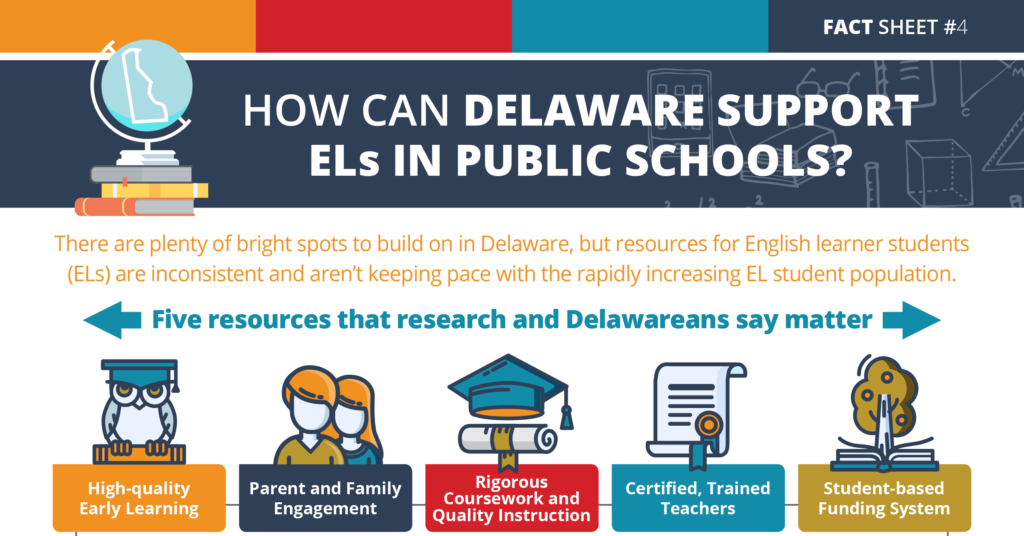5 NEW THINGS WE LEARNED ABOUT EL STUDENTS THIS YEAR

Back in fall of 2017, Rodel, along with the Delaware Hispanic Commission and the Arsht-Cannon Fund, published a series of award-winning fact sheets about English learners in Delaware—a demographic that represents the fastest growing segment of students in the state by far.
Since that time, Delaware began implementing new accountability and reporting systems for schools across the state, which has many implications for those that care about English Learners. Delaware’s new accountability system includes increased recognition of English learners and their academic progress.
This is all good news: We need good data to make informed decisions that help our students succeed. At the same time advocates and policymakers continue to push for essential supports for EL students, including equitable, per-pupil funding that follows student needs.
Here are five things we’ve learned in the last year:
- New recognition and data for ELs
Thanks to the Every Student Succeeds Act, Delaware is now officially tracking English Language Proficiency, a new measure that tells us the percentage of ELs making progress toward reading, writing, and speaking English in each school.
Additionally, as part of the state’s attempt to track college and career readiness in high schoolers, we’ll see for the first time the number of students who received a certificate of multiliteracy at their school. There are also implications for EL students in Delaware’s new approach to low-performing schools. School with a subgroup of students (i.e. English learners) performing at or below the bottom five percent of all schools receive additional support and improvement interventions.
- New reporting for families
The new-look school report cards will help EL families make informed decisions about their schools. At the state, district, and school levels, English learners will be measured on:
- The number and percentage of students at each of three or more levels of achievement on each of the academic assessments in mathematics, reading/language arts, and science
- Results on each measure included within the Academic Progress indicator
- The four-year adjusted cohort graduation rate
- Results on each measure included within the School Quality or Student Success indicator(s) (On Track Attendance, Social Studies, CCP, On Track in 9thGrade)
- The number and percentage of English learners achieving English language proficiency
Increased awareness of English learner data is critical to public transparency; it will also help districts and schools monitor student growth targets and disaggregate EL student data so that they can make informed decisions while planning for possible fiscal investments.
- ELs are (still) the fastest growing student population
As we noted in our first EL Fact Sheet, the EL student population grew 428 percent over the last 20 years—making them Delaware’s fastest growing student population. ELs make up nearly 10 percent of public school students, more than 13,000 students.
- ELs still need academic support
An achievement gap persists between ELs and native English-speaking students from elementary school to postsecondary. Fact sheet number three explains how under-resourcing EL students (lack of sustained funding and chronic teacher shortage) may contribute to the achievement gap.
| English Learner Report Card | |||
| Category | Description | English Learners | Native English Speakers |
| 3rd grade Smarter Balanced Reading and Math
(2017-2018) |
Percentage of students on grade level in third grade reading and math | Reading: 36%
Math: 42% |
Reading: 55%
Math: 56% |
| SAT Reading and Math
(2017-2018)
|
Percentage of high school students on grade level in reading and math | Reading: 5%
Math: < 5% |
Reading: 52%
Math: 30% |
| Graduation Rates (2018) | Percentage of students who graduate high school in four years | 75% | 87% |
| College Remediation*
Class of 2015 |
Percentage of students who enroll in college who may not be able to take credit bearing courses until completing remedial courses | 49% | 41% |
*Note: College remediation data are the most up-to-date data available and taken from Delaware English Learner fact sheets. Smarter Balanced and SAT assessment data have been taken from Delaware Student Assessment Reporting & Analysis for the Public DSARA; Graduation Rates data have been provided by Delaware Department of Education 2017-2018 Graduation Summary Statistics.
- Opportunity funds will help EL students, but a long-term solution still elusive
Governor John Carney recommended $75 million to expand his Opportunity Funding initiative. The funding aims to provide weighted funding for low-income and English learner students in schools across Delaware, which could be spent flexibly on things like additional reading and math specialists, counselors, trauma-informed training, after-school programming and smaller class sizes, and more.
It’s a step in the right direction because, as Carney’s office notes, “Delaware is one of only a handful of states that does not target additional resources for low-income and English learner students – students who we know need additional resources to reach their fullest potential.”
Organizations like Education Equity Delaware and the Delaware Hispanic Commission continue to advocate for a permanent fix to Delaware’s 70-year-old “unit count” system in favor of a flexible system where dollars follow students.
Want to get involved and advocate for EL students? Check out our fact sheets for some ideas.